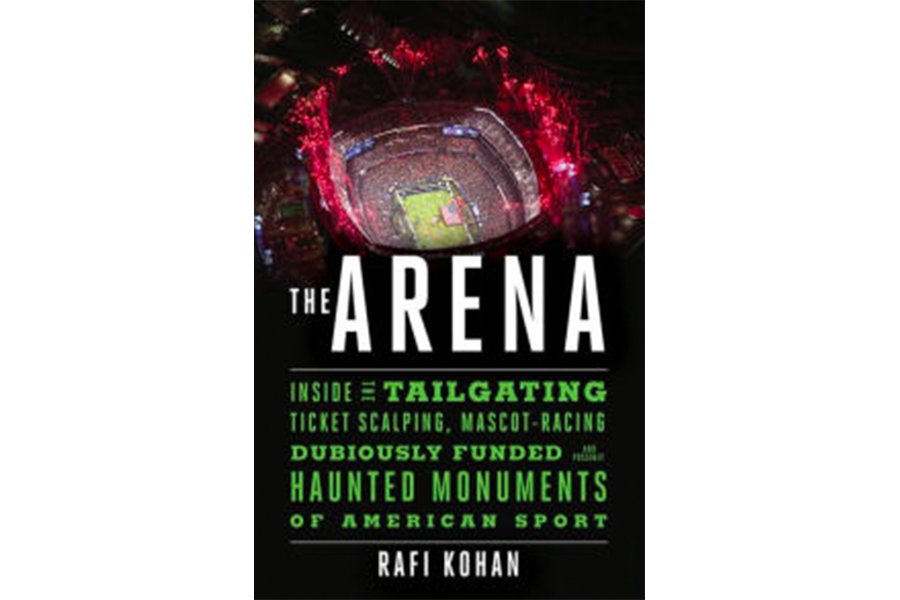'The Arena' explores America's stadiums and their relation to the national character
Loading...
Oath of the Lambeau Virgin: “I, Rafi Kohan, do solemnly swear to uphold the standards of Packer Nation, to worship at the hallowed ground that is Lambeau, to honor and cherish the players and coaches that came before, to lose my voice at every game I attend, to wear cheese as an accessory ... so help me God....”
That’s author Kohan, ever the good sport, being inaugurated by the over-served mayor of Lambeau Field into an American institution that has best been described by another author as “a kind of secular faith.”
On the following football Sunday, down in Arlington, Tex. at AT&T Stadium, the Dallas Cowboys’ new home – aka “Jerry’s World,” “The Eighth Wonder of the World,” and “the humming cash factory” – there’s Kohan again, eyes boggling, watching as the DJs, live bands, pyro shows, drumming teams, go-go dancers, and hyper-choreographed cheerleader routines that serve as an ever-jangling set of shiny keys treat the crowd like kittens with ADD” inside a three-million-square-foot, futuristic stadium with “sixty-yard-long center-hung video boards that weigh more than a million pounds and draw eyeballs like moths to a flame.”
These are just a couple of the arenas – “the concrete monuments and fluid social spaces” – that author Kohan visited in his quest to discover perhaps the purest embodiment of American exceptionalism there is. And just like the intent of every venue he visits, The Arena is fun.
It’s fun because of the author’s wit and style – a kind of gonzo/embedded journalism hybrid, as seen here, in Kohan's interactions with Roses, a Cleveland ticket scalper. "'This is cutthroat, man,’ [Roses] says, slurring his words, inches from my ear. ‘This is about who’s eating good, who’s drinking good, and who’s sleeping on the street...’ I nod along ... [then he] slides his knife along my back, holds it there. He is giving off a last-grizzly-before-winter sort of vibe, desperate. But I know he’s telling the truth.”
It’s fun because of the cast of crazies we meet, like “Sladek, who at fifty-seven billed himself as ‘America’s oldest daredevil acrobatic hand balancer’ ... [and] began his act, known as the Tower of Chairs. On top of a folding table placed at center court, he methodically balanced six wooden chairs, one after another, end on end, climbing spindles all the way to the top.” Or Brad Collins, the Kansas City Royals’ mascot: ”He bemoans the effect technology has had on his craft, on crowd work. ‘It has ruined improv humor for mascots. The performance art in the stands is done. Anytime you start a gag, you have people come up and pull your tail, just trying to take a picture.’”
But most importantly it’s fun because it is, metaphorically speaking, a circus mirror reflection of who we are as a nation “psychologically, economically, politically, culturally, historically.”
It is, also, a bit of a sprawl. We look from every angle and every vantage point, human as well as structural, at this most American of subjects: from luxury suites to bathrooms, from menacing ticket scalpers to OCD groundskeepers, from conniving club owners to out-of-control fans. Nothing and no one is left out or avoided in this sedulously researched, hands-on (Kohan worked as Sladek’s assistant during a Rutgers men’s basketball game, lifting chairs on poles to the daredevil), up-close-and-personal account of his visits to the arenas and the people who care about and for them.
Of Wrigley Field’s renovations (Wrigley is one of the two ballparks still around having been built of permanent steel and concrete into urban neighborhoods early in the last century), “a five-phase overhaul that will effectively leave the Cubs with an all-new building, right down to the concrete and steel,” Kohan wonders how one “safeguards a ballpark’s soul?” Yeah, that’s the big question, the Cubs’ president agrees.
As for the new Yankee Stadium ... Kohan deeply misses the old stadium.
In the chapter entitled “Super Subsidize Me,” Kohan explains how government subsidies work to the advantage of the owners: “The Tax Reform Act ... [had] a loophole ... that actually encouraged cities to strike deals that were less favorable, in order to still qualify for tax-free borrowing.... [T]he loophole essentially forces ‘cities to fund only facilities that were guaranteed money losers.’” People aren’t getting their money’s worth, although some studies prove that being a sports fan has some benefits, “including higher self-esteem and fewer feelings of depression and loneliness." Yet other studies prove that watching sports can increase aggression.
Kohan does not avoid the taboo, either. At Penn State, he snoops around, inquiring and observing the effects of the Jerry Sandusky scandal on Happy Valley (“the stands today – on homecoming, no less – are far from full”). In New Orleans, he interviews survivors of the horrors that occurred at the Superdome during Hurricane Katrina, where, for five agonizing days, 16,000 people existed in hellish conditions, some victims of rape and even murder, but more egregiously all casualties of the failure of the US government to expeditiously respond. The Superdome reopened in 2006, and the Saints came marching in, winning a Super Bowl in 2010 and selling out their season tickets every year since then.
As for the “extremely loud and incredibly gross” fans in the stands... well, you’ll have to read those for yourself to understand why this book as a reflection of who we are “as individuals, as cities, and as a society” really hits it out of the ballpark!
Richard Horan is an award-winning author of two novels: "Life in the Rainbow" and "Goose Music," and two non-fiction books: "Seeds" and "Harvest."






